From what I've read here, saw in advertisements, and similar, I would expect that the reason for the popularity of the SuperSpeed was a combination of advertising, simplicity for the end user, and the implied additional safety of not having to risk playing with the edges of a blade when loading and unloading the razor. (The whole 'unwrapped blade in cartridge' where you didn't even have to put your fingers close to the edge to load it into the razor)
You are using an out of date browser. It may not display this or other websites correctly.
You should upgrade or use an alternative browser.
You should upgrade or use an alternative browser.
Super Speed Razors: The Post World War II Shaving Culture in America to 1955
- Thread starter mgbbrown
- Start date
- Thread starter
- #522
As service men returned Stateside following cessation of hostilities and Japan's surrender to allied forces, initially announced by Emperor Hirohito to the people of Japan in the Jewel Voice Broadcast of August 15, 1945, and following the formal signing of the Japanese Instrument of Surrender aboard the USS Missouri, moored in Tokyo Bay on September 2, 1945, they simply wanted to resume the life they had left behind. Many looked for peace and quiet, and the opportunity to separate themselves from their regimented lifestyle and the horrors of war. Others wanted to experience the thrills that they had in combat, throwing themselves wholeheartedly into the pursuit of a faster automobile, or building that Hot Rod they had planned during a return from a successful mission over Germany while staring out over the British countryside through the window of their waist gun or ball turret.
Gillette in Boston would quickly re-tool as well, as they had been summarily released from their wartime contracts by the War Production Board. The good news for Gillette, was that razor blade production and supplying armed forces personnel with an inexpensive shaving kit was not too far removed from their peacetime efforts. The Contract Tech was produced by Gillette and other manufacturers as a three-piece razor following the design of the Bakelite or Ball-End Tech. The example pictured below was delivered in a thin cardboard box with the contents printed on one full side of the box:
1 RAZOR, SAFETY, with 5 BLADES
IN PLASTIC CASE
GILLETTE SAFETY RAZOR COMPANY
Printed on one side only are the United States patent numbers for the razor and plastic case, which was made of Bakelite:
RAZOR U.S. PAT. NO. 1,815,745; No. 1,858,316; No. 2,270,388
PLASTIC CASE U.S. DES. PAT. NO. 135,381
These were issued during induction, but could also be purchased individually from the ship's on-board store or from the unit's supply quartermaster. This particular example was perhaps purchased in such a manner, as it has twenty-five cents penciled on the box. Inside was a brown Bakelite hinged case, roughly 3 and 3/4 inches long, two inches wide at the center latch, and 3/4 inch thick, with a Gillette diamond logo molded into the center of the lid. Case contents included a three-piece razor and a pack of razor blades. The cast Ball End Tech handle was made from a non-ferrous metal with a non-reflective black coating. The razor base plate was steel and coated in the same manner, whereas the cap was also cast in a non-ferrous metal, threaded to mate to the handle, and coated to have the same non-reflective black finish. Inside too are an unopened box of Gillette Thin Blades, with a copyright date of 1938. The razor head and cap assembly are covered with a paper card instructing the user to purchase only Gillette blades, as his Contract Tech was designed specifically for them. I doubt that this would be of any serious concern to the foxhole shaver, air corpsman, or sailor using his razor during the war. God Bless! Tony Brown RN mgbbrown
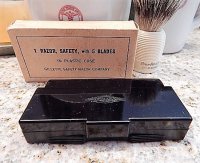
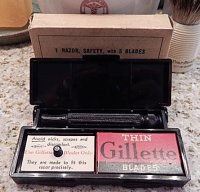
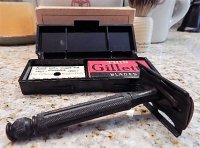
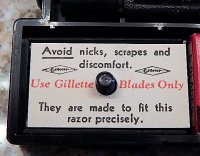
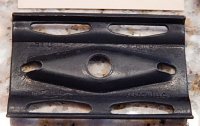
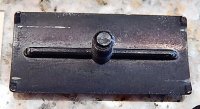
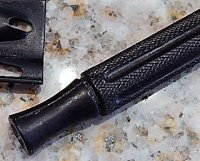
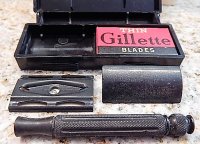
Gillette in Boston would quickly re-tool as well, as they had been summarily released from their wartime contracts by the War Production Board. The good news for Gillette, was that razor blade production and supplying armed forces personnel with an inexpensive shaving kit was not too far removed from their peacetime efforts. The Contract Tech was produced by Gillette and other manufacturers as a three-piece razor following the design of the Bakelite or Ball-End Tech. The example pictured below was delivered in a thin cardboard box with the contents printed on one full side of the box:
1 RAZOR, SAFETY, with 5 BLADES
IN PLASTIC CASE
GILLETTE SAFETY RAZOR COMPANY
Printed on one side only are the United States patent numbers for the razor and plastic case, which was made of Bakelite:
RAZOR U.S. PAT. NO. 1,815,745; No. 1,858,316; No. 2,270,388
PLASTIC CASE U.S. DES. PAT. NO. 135,381
These were issued during induction, but could also be purchased individually from the ship's on-board store or from the unit's supply quartermaster. This particular example was perhaps purchased in such a manner, as it has twenty-five cents penciled on the box. Inside was a brown Bakelite hinged case, roughly 3 and 3/4 inches long, two inches wide at the center latch, and 3/4 inch thick, with a Gillette diamond logo molded into the center of the lid. Case contents included a three-piece razor and a pack of razor blades. The cast Ball End Tech handle was made from a non-ferrous metal with a non-reflective black coating. The razor base plate was steel and coated in the same manner, whereas the cap was also cast in a non-ferrous metal, threaded to mate to the handle, and coated to have the same non-reflective black finish. Inside too are an unopened box of Gillette Thin Blades, with a copyright date of 1938. The razor head and cap assembly are covered with a paper card instructing the user to purchase only Gillette blades, as his Contract Tech was designed specifically for them. I doubt that this would be of any serious concern to the foxhole shaver, air corpsman, or sailor using his razor during the war. God Bless! Tony Brown RN mgbbrown








- Thread starter
- #523
You are exactly right Bookworm, and thank you for your post! I will be expanding on just that topic in the days ahead, as it predicated the evolution from the earlier Ranger Tech. As I mentioned above, returning servicemen, especially US Army Air Corps officers who were stationed in England, were able to afford the fine British razors available to them to purchase while on leave, and would bring them back Stateside upon there return. Likewise, other service personnel just wanted something better to use, or did not remind them of there experiences overseas. Regardless of purchasing motivation, Gillette would need to quickly respond to a rapid and monumental demand for their products. Initially this would involve putting the Ranger Tech back into production, as tooling already existed and a supply of parts from the 1941 model was available. This of course, was followed in 1947 by the introduction of the Super Speed razor and the newly designed tan Speed Pak razor blade dispenser. God Bless! Tony Brown RN mgbbrown
I'm going to go back and start working my way through this thread, from the beginning, but I wanted to post my weekend finds here (I already posted them on the acquisition thread) as they're both Superspeeds, and I believe one is the Tan Tip, or Brown Tip in my case.
Pictured are a B4 1956 Blue Tip and a W3 1951 Black Tip.
I've read elsewhere on B&B about how Gillette recieved a batch of knobs that were the wrong color, but they used them anyway. Makes sense - why throw out good knobs when you're trying to save money.
How rare are these Tan/Brown Tips? Are they worth more than the standard Black Tip? I'm not really interested in monetary value - I'm not into selling/trading my vintage finds. I just think it would be cool to know that I was able to acquire something rare and hard to find. I know it won't make it shave any differently, but it would certainly add more to the shaving experience when I use this razor - yes, I use all my vintage razors! While to some degree they are works of art, they were well crafted in the good ole USA, with a specific purpose in mind - to be used!
Thanks!
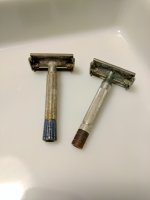
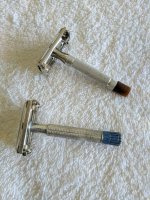
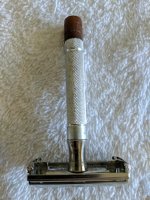
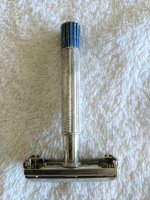
Pictured are a B4 1956 Blue Tip and a W3 1951 Black Tip.
I've read elsewhere on B&B about how Gillette recieved a batch of knobs that were the wrong color, but they used them anyway. Makes sense - why throw out good knobs when you're trying to save money.
How rare are these Tan/Brown Tips? Are they worth more than the standard Black Tip? I'm not really interested in monetary value - I'm not into selling/trading my vintage finds. I just think it would be cool to know that I was able to acquire something rare and hard to find. I know it won't make it shave any differently, but it would certainly add more to the shaving experience when I use this razor - yes, I use all my vintage razors! While to some degree they are works of art, they were well crafted in the good ole USA, with a specific purpose in mind - to be used!
Thanks!




- Thread starter
- #525
Tipster; Yours is a Black Tip Super Speed that has experienced quite a bit of UV exposure in its day to cause that type of discoloration from the original black Bakelite. I have encountered it quite often in salvaging MGB bits from early versions which featured Bakelite steering wheel horn push nacelles or mounts. Mine is a W3 example, produced during the third quarter of 1951. My guess is that Gillette used a supply of the tan TTO knobs as a stopgap from a secondary supplier to keep the assembly lines running, or had a supply of these on hand as a potential variant, as they also had a brass tipped version in production for a brief period in the second quarter of 1951 when this Super Speed type first appeared. Great score Sir! As for value, they were produced for a very short period, but do rear their head from time-to-time. Mine had seen far better days, and was restored using an excellent aluminum Black Tip W3 as an exact donor to replace the damaged W3 aluminum handle that was originally attached to the knob. Our Cap did the honors, and from accidently breaking a black tip TTO knob in the process- the black material was confirmed to be Bakelite due to the presence of asbestos used as a filler. God Bless! Tony Brown RN mgbbrown
If it's UV exposure, then I suspect the person using it would shave in a bathroom with a small window, and would set the razor on the window ledge. I do this myself when I'm shaving in the shower, because the window is just outside the shower curtain. Bathroom windows are high enough that a casual grab from a small human isn't likely to get them sliced up, and they won't have it in view to draw the attention to try to drag something over to climb up.
- Thread starter
- #527
Bookworm; That is a good thought, combining that with improper rinsing and cleaning over the years of use. Nicotine also is a discoloring agent in a similar sense, and possibly could have degraded the Bakelite. I have seen one other Black Tip that looked as this one does. Thanks for the reply! God Bless! Tony Brown RN mgbbrown
Tony,
Before you graduate to Heaven, we've got to find a way to make a digital copy of your brain! Too many shavers coming up to lose the wealth of knowledge (blessing) that lives inside of you!!
Before you graduate to Heaven, we've got to find a way to make a digital copy of your brain! Too many shavers coming up to lose the wealth of knowledge (blessing) that lives inside of you!!
- Thread starter
- #529
Thank you so much Ozark Kedger! I have always possessed an enthusiasm for life which equates to having my glass more than half full, I can assure you. I do think that once the smoke clears in all of this, that a certain simplicity will prevail- it is that peace that transcends all understanding. Pursuits such as this too serve to separate ourselves from the pervasive evil in this world, and make us all too aware of the wonders of creation and the joys of life that we have been so freely given. God Bless! Tony Brown RN mgbbrown

- Thread starter
- #530
Being a Luddite at heart has certainly allowed for a greater appreciation of that early Super Speed culture in America, and has factored heavily in my building a 1950's office. About twenty years ago, I stumbled across an old telephone at the Flea Market in Raleigh, located at the North Carolina State Fairgrounds and operational on the weekends; the phone of course reminding me of my childhood days in Columbia, South Carolina before moving to Raleigh in 1963 after the close of school and completion of second grade. Rotary telephones, with a circular finger wheel for dialing, and a large handheld receiver, were both iconic (think of I Love Lucy) and a central fixture in most homes during the late 1950's and early 1960's. There were no such things as mobile telephones, save the one found in Bruce Wayne's Batmobile, made to real-life from our DC Comics by custom car builder George Barris using the Lincoln Futura from his collection in 1966.
We were fortunate to have our own private line rather than a party line, as this was necessary for my father's pharmaceutical business with Parke-Davis and placing his orders following a day on the road. Otherwise, one would have to wait for a dial tone, indicating that the line was free to use. The Columbia exchange that serviced our neighborhood was SU for SUnset, which coincidentally was the same exchange that was in Raleigh when we moved there. Our home phone number on Foxhall Road was SU 7- 9759. As it turns out, the telephone that I found at the Flea Market was a transitional Western Electric 5302 produced in 1955, my birth year, with a large Bakelite F1 handset and a case which looked like the black 500 series telephone that we had at our house. It already had a modular cord and jack, but would echo when you spoke into the mouthpiece and the bells did not ring when the line was called. The dial and number wheel were in good order cosmetically, but the case had suffered quite a bit of abuse and needed much attention. My efforts would center on making the 5302 as close to original as possible, complete with four-prong jack and cloth line cord. Refurbishing older telephones, as it turns out, is quite popular, and original parts are readily available. Inside the case, the chassis was cleaned, all components tested, and the echo at the earpiece was found to have been caused by an improperly wired handset line, which was easily rectified and the two bells reset to ring when the line was called. The case was progressively sanded and polished until all irregularities were removed, and thankfully was done well in advance of my current respiratory condition and was not a factor in its development. I chose to use a private line dial card that was available from Southern Bell in 1955. The number SU 7- 9759, was typed in much the same manner as it would have been done in period using the 1949 Royal Quiet Deluxe typewriter that I had also refurbished for my 1950's office desk, which in and if itself is another story and is also


 an integral part of the early Super Speed culture in America. God Bless! Tony Brown RN mgbbrown
an integral part of the early Super Speed culture in America. God Bless! Tony Brown RN mgbbrown
We were fortunate to have our own private line rather than a party line, as this was necessary for my father's pharmaceutical business with Parke-Davis and placing his orders following a day on the road. Otherwise, one would have to wait for a dial tone, indicating that the line was free to use. The Columbia exchange that serviced our neighborhood was SU for SUnset, which coincidentally was the same exchange that was in Raleigh when we moved there. Our home phone number on Foxhall Road was SU 7- 9759. As it turns out, the telephone that I found at the Flea Market was a transitional Western Electric 5302 produced in 1955, my birth year, with a large Bakelite F1 handset and a case which looked like the black 500 series telephone that we had at our house. It already had a modular cord and jack, but would echo when you spoke into the mouthpiece and the bells did not ring when the line was called. The dial and number wheel were in good order cosmetically, but the case had suffered quite a bit of abuse and needed much attention. My efforts would center on making the 5302 as close to original as possible, complete with four-prong jack and cloth line cord. Refurbishing older telephones, as it turns out, is quite popular, and original parts are readily available. Inside the case, the chassis was cleaned, all components tested, and the echo at the earpiece was found to have been caused by an improperly wired handset line, which was easily rectified and the two bells reset to ring when the line was called. The case was progressively sanded and polished until all irregularities were removed, and thankfully was done well in advance of my current respiratory condition and was not a factor in its development. I chose to use a private line dial card that was available from Southern Bell in 1955. The number SU 7- 9759, was typed in much the same manner as it would have been done in period using the 1949 Royal Quiet Deluxe typewriter that I had also refurbished for my 1950's office desk, which in and if itself is another story and is also
Thank you so much Ozark Kedger! I have always possessed an enthusiasm for life which equates to having my glass more than half full, I can assure you. I do think that once the smoke clears in all of this, that a certain simplicity will prevail- it is that peace that transcends all understanding. Pursuits such as this too serve to separate ourselves from the pervasive evil in this world, and make us all too aware of the wonders of creation and the joys of life that we have been so freely given. God Bless! Tony Brown RN mgbbrown View attachment 763157
Well stated. And true!
Guys - Thanks for all the info on my brown tip SS! I feel like even though I've learned so much about the vintage razors I've collected so far, I've barely scratched the surface. Lots to look forward to!!
mgbbrown - I'm from NC also. I know it's a long shot, but maybe I'll bump into you in an antique store somewhere, if the fates allow it. I have a daughter who goes to school Boone, and we've been meaning to hit the shops up that way for some time now. Thanks, again!
mgbbrown - I'm from NC also. I know it's a long shot, but maybe I'll bump into you in an antique store somewhere, if the fates allow it. I have a daughter who goes to school Boone, and we've been meaning to hit the shops up that way for some time now. Thanks, again!
- Thread starter
- #533
Tipster; My wife and I live in the north-central, North Carolina Piedmont not horribly far from the Virginia border. South Boston, Virginia is one of our favorite places for antique-ING in general. The antique mall in Boone across from Mast Store always has something from the past that I find interesting. I welcome the opportunity Sir!
Thank you Steve! Attitude is the great determinate of happiness, and permeates the lives of others through enthusiastic living and cheerful service. God Bless! Tony Brown RN mgbbrown
Thank you Steve! Attitude is the great determinate of happiness, and permeates the lives of others through enthusiastic living and cheerful service. God Bless! Tony Brown RN mgbbrown
Tony, you may know but the classic Western Electric handset and the late '40s Royal Deluxe typewriter were both designed by Henry Dreyfuss. He was one of the top industrial designers of the mid 20th Century and was responsible for the look of many iconic products.
- Thread starter
- #535
Tony, I've always been a Raymond Lowey fan since he designed many of the iconic Pennsylvania Railroad locomotives. My grandfather was an engineer on the Pennsy though unfortunately he passed away before I got to meet him. I'm sure you know that Lowey's most iconic design was of the Coke bottle. Lowey and Dreyfuss really had 1930's and 40's design wrapped up!
That Royal Quiet Deluxe is a handsome typewriter. I can't wait to see the pics of the 1950's office when you get it finished.
That Royal Quiet Deluxe is a handsome typewriter. I can't wait to see the pics of the 1950's office when you get it finished.
At least it isn't Frank Lloyd Wright designs. That man was a menace.
- Thread starter
- #538
Thanks for your reply Mike- right after I settled down in my first real job as a fledgling archaeologist, I became interested in the very early Coke and Pepsi bottles. I believe that I have one of his famous 1923 Christmas Patent Office bottles in the collection, and I do have a 1920's Coke advertisement cosmetic mirror in another shadow box frame that will be displayed in the office. Perhaps I can lay my hands on them for you. I know that before Loewy's design, Coke had a straight-sided bottle around 1915. If I remember- I should have one for comparison. The typewriter should be up to bat soon...
Book; I toured the Johnson Wax building in Racine, Wisconsin, but only saw the hardy House from the Road. God Bless! Tony Brown RN mgbbrown


Book; I toured the Johnson Wax building in Racine, Wisconsin, but only saw the hardy House from the Road. God Bless! Tony Brown RN mgbbrown
My wife, when she was working in Detroit, had a friend that worked in one of his 'futuristic' designs. It always leaked, because his attitude was "Screw the limits of the material - go BEYOND the limits!". All of the constructions he was allowed to spec out had problems such as that.
- Thread starter
- #540
Now that you mention it- I think the Johnson Wax building was undergoing extensive repairs for water damage in 1985 or so when I was there. God Bless! Tony Brown RN mgbbrown
Similar threads
- Replies
- 35
- Views
- 7K
- Replies
- 2K
- Views
- 129K
- Replies
- 206
- Views
- 76K
- Replies
- 24
- Views
- 8K
